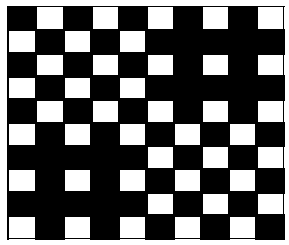Know Your Handloom: Weaves of Woven Fabrics

The weave is the interlacment of warp and weft yarns to produce a woven fabric. Fabrics are manufactured in wide varieties and designs. The basic weaves are plain, twill and satin. All the others are derivatives of these basic weaves or their combination.

Different basic weaves structures
A. Different types of Weaves and their names:
- Plain Weave
- Twill Weave
- Satin & Sateen Weave
- Honey Comb Weave
- Huck a Back Weave
- Crepe Weave
- Bedford Cord Weave
- Welts and Pique
- Mock Leno Weave
- Leno Weave
- Backed cloth
- Terry Pile
- Velvets and Velveteens
- Double cloth
- Tubular cloth
Details of each weave are as follows:
- Plain Weave
Plain is the simplest weave, in which warp and weft threads interlace in alternate manner as shown below, giving maximum number of interlacements. This maximum interlacement imparts firmness and stability to the structure. Atleast two ends and two picks are required to weave its basic unit. A minimum of two heald frames are required for this weave. It is used in cambric, muslin, blanket, canvas, dhothi, saree, shirting, suiting etc.

Plain weave
Plain weaves are basically three types. They are:
a) Warp Rib
b) Weft Rib
c) Matt Weave
a) Warp rib:
Warp rib is a modified form of plain weave. It has 1/1 interlacements in the filling direction, which differs from the simple plain weaves. This modified interlacement results in the formation of cords, ridges, or texture across the warp direction of the fabric. It requires two heald frames at least, but multiple of these can also be employed. The number of weft yarns in a repeat unit of this weave is equal to the sum of the digits in formula of warp rib. For example, 2/2 warp rib requires 2 warp yarns and 4 weft yarns. Design of the above-stated warp rib is shown below. Warp rib is also known as ottoman.

Warp rib (2/2)
b) Weft Rib
Weft ribs are another modified form of plain weave. It has 1/1 interlacements in the warp direction, which differs from the simple plain weave. This modified interlacement results in the formation of cords, ridges, or texture across the weft direction of the fabric. It requires two heald frames at least, but multiple of these can also be employed. The number of warp yarns in a repeat unit of this weave is equal to the sum of the digits in formula of warp rib. For example, 2/2 weft rib requires 2 weft yarns and 4 warp yarns. Design of the above-stated weft rib is shown below. Weft rib is also known as half panama.

Weft rib (2/2).
c) Matt Weave
This type of weave is constructed by extending the plain weave in warp and weft directions at the same time so that two or more threads work alike in both directions. In this weave, the same size of squares appear on both sides of the fabric showing the same number of warp and weft yarns on front and back of the fabric. Matt weave is also commercially known as basket, hopsack, or full panama. Design of the 2/2 matt weave is shown below.

Matt weave (2/2)
Twill Weave:
Twill weave is another basic weave, which is well known for its diagonal line formation in the fabric due to its interlacing pattern. This weave and its derivatives are used for the ornamental purposes. Twill has closer setting of yarns due to less interlacement imparting greater weight and good drape as compared to the plain weave. In simple twill, the outward and upward movement of the interlacing pattern is always one that imparts a diagonal line to this design. The direction of the propagation of twill line classifies twill into right-hand or left-hand twill. Twill weaves find a wide range of application such as drill cloth, khakhi uniforms, denim cloth, blankets, shirtings, hangings and soft furnishings.

2. Twill weave
Derivatives of Twill Weave:
- Broken twill
- Diamond design
- Elongated design
- Shaded twill
- Zigzag/waved/pointed twill
- Combined twill
- Herring bone twill
Broken Twill:
This is obtained by breaking the twill line of regular twill. It is somewhat similar in appearance to Zigzag twill. Broken twill can be obtained in different ways. At first, basic twill is divided into two sections, then the first section is unchanged and the second section is reversed.

Broken twill
Diamond design
It is a derivative of twill weave. It is obtained by combining horizontal and vertical zigzag twill. In this weave pointed design is obtained.

Diamond design
Elongated Twill
Normally, the twill angle is 45 degree where the ends and picks per unit area are equal. But in elongated twill, the twill angle is more or less than 45 degree.
Shaded twill
By shaded twill, we can create shaded effect on fabric. The shade effect is created by the combination of some thick to thin twills or thin to thick twills.

Shaded twill
Zigzag/waved/pointed Twill:
It is the simplest and one of the most important modifications of twill weave produced by reversing the direction of twill at suitable interval.
A point is selected (usually the last warp is selected) as the reversing point and so it is sometime called as pointed twill. This twill is produced by combining S and Z twist. According to reversing of direction, there are horizontal and vertical zigzag twill:

Horizontal zigzag twill

Vertical zigzag twill
Combined Twill
In these types of weave, two different types of continuous twills are combined together alternately. The combination may be warp way or weft way. The angle of twill is influenced by the method of combination.
Herring Bone Twill
Herringbone, also called broken twill weave, describes a distinctive V-shaped weaving pattern usually found in twill fabric. The pattern is called herringbone because it resembles the skeleton of a herring fish. Herringbone-patterned fabric is usually wool, and is one of the most popular cloths used for suits and outerwear. Tweed cloth is often woven with a herringbone pattern.

Herring Bone Twill
3. Satin & Sateen:
Satin/sateen is a basic weave that does not have any regular pattern like twill. The surface of the fabric is either warp or weft faced. Satin is warp faced, which means that all the surface of the fabric will show the warp threads except for the one thread interlacement with other series of yarn. If it is weft faced, then it will be known as sateen, which means that fabric surface will show the weft threads mostly. These weaves have the least interlacement points among the basic weaves. Due to this reason, it gives the surface of fabric more lustre and smoothness. With this weave it is possible to use a cotton warp and silk filling, having most of the silk appearance on the surface of the fabric. It is used in sarees, blouse materials, dress materials, bed spreads, furnishing fabrics, curtain fabrics etc.

Satin weave

Sateen Weave
4. Honey Comb Weave:
This name is given to this weave due to its honey bee web-like structure. It makes ridges and hollow structures, which finally give a cell-like appearance. In this weave, both warp and weft threads move freely on both sides, which coupled with rough structure. The fabric made by this weave has longer float all over the fabric. Due to this reason, it is radially absorbent of moisture. This property made these weaves useful for towels, bed covers, and quilts. This weave is further divided into three types which are explained below. Most commonly, these weaves are constructed on repeats which are multiple of four in ends and picks.

Honeycomb weave
5. Huck a Back Weave:
This weave is largely used for cotton towel and linen cloth. It has longer floats in two quadrants, which make them more moisture absorbent. This weave is combination of longer floats of symmetric weaves in two quadrants and plain weaves in the remaining two quadrants. Plain weave gives firmness to the structure, while longer float weave increases the absorbency of fabric, making it suitable for the above-stated purpose. Sometimes, longer float symmetric weaves are used in combination of plain weaves in huck a back weave, which is also termed as honey comb huck a back weave.

Huck a back weave
6. Crepe Weave:
Crepe weave refers to the weave that do not have any specific pattern. The weave may contain a little bit appearance of twills, but they do not have the prominence. They make small patterns or minute spots and seed-like appearance all over the fabric surface. The weave may be used separately or in combination with other weaves. Crepe weave is frequently employed in making the ground of the figured fabrics. In simple words, crepe weave is used to make a rough appearance. If we make crepe weaves with crepe yarns, this combination will give more remarkably pebbly or puckered appearance.

Crepe (sateen based), 7 ends
7. Bedford Cord Weave:
This is a special class of weave that forms longitudinal warp lines in fabric with fine sunken lines in between. This fabric is used in suiting for ornamental purposes. The method to construct this weave is simple. The repeat of the weave is calculated by multiplying the cord ends by two. The resultant value will be the total number of ends of the weave repeat. The pick repeat is four for this weave. The weave repeat (warp ends) is divided into two halves to construct it. The first and last ends of both the halves are treated as cutting ends. Plain weave is inserted on these cutting ends. These plain ends behave as sunken ends in the Bedford cord.

Bedford cord weave, 10 threads cord with 2 waded ends
8. Welts and Pique:
A pique weave consists of plain face fabric, which is composed of a series of warp and weft threads along with a series of stitching threads. This weave is unique due to the formation of horizontal lines (weft wise). This weave requires two beams, one for the plain weave threads and the other for stitching ends. The word “welt” is concerned to the pique construction, when the indentations make deep or hollow (sunken) lines appear in the cloth.

Welts and pique weave
9. Mock Leno Weave:
This weave is much similar to a gauze-type fabric. The weave is constructed in four quadrants. The first and third quadrants have symmetric weave, and the second and fourth quadrants have opposite weave to the symmetric weave. The perforated fabrics are made by this type of weave. This effect is achieved by reversing the symmetric unit of the weave in the alternate quadrants. So, these weaves are produced in sections that oppose each other.

Mock leno weave
10. Leno Weave
Also known as Gauze or Cross weaving, Leno weave is a weave in which two warp yarns twist and grip tightly around the weft yarns. This makes for a more open weave that can be woven tightly for shirting or left completely loose to resemble netting or mesh.

11. Backed cloth:
The weave combines 2 or more different weaves but the weave on one side is not visible on other side. For example: sateen on face side and twill on back side is woven with appropriate stitches. Using this weave, 2 different types of yarn can be woven on face and back side of fabric. For example; linen on face side and cotton on back side can be woven. This combination will give good comfort to the wearer and along with elegant appearance.
12. Terry Pile:
This weave is unique in nature by producing loop piles on the fabrics. These weaves are used in toweling fabrics. More popularly these towels are known as Turkey towels or terry towels. These towels are more popular for their water absorbency.
13. Velvets and Velveteens:
These are cut pile fabrics more popularly used for rich furnishing and made up fabrics. They are also used for jewel boxes, car upholstery etc.
14. 
Double cloth:
Double cloths are fabrics, in which there are atleast two series of warp and weft threads each of which is engaged primarily in producing its own layer of cloth, thus forming a separate face cloth and a separate back cloth. The purpose of the construction is to improve the thermal insulation value of a fabric with smart face appearance. Double cloths are used as different types of decorative cloth such as – sofa cover, furnishing cloth, curtain fabric, bed cover, pillow cover and other home textiles. It is also used for the production of winter garments, quilts, belts, different types of industrial fabrics etc.
a. Self-stitched double cloth
These fabrics contain only the two series of threads in both directions and the stitching of the face cloth layer to the back layer is accomplished by occasionally dropping a face end under a back pick or by lifting a back end over a face pick or by utilizing both of the above systems in different portions of the cloth.

b. Centre-stitched double cloths
In these fabrics, a third series of threads is introduced either in the warp or in the weft direction whose entire function is to stitch the two otherwise separate layers of cloth together. The center threads lies between the face and the back cloth for the purpose of stitching oscillate at regular intervals between the face and the back thus achieving the required interlayer cohesion as shown at the following figure.

15. Tubular cloth:
It is a double cloth woven without stitching points between the face and back fabrics. When we take out the fabric from loom, it will be a tube made-up of fabric.





